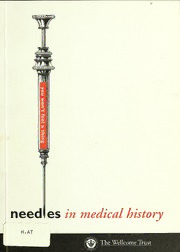
Needles in medical history [electronic resource] : an exhibition at the Wellcome Trust History of Medicine Gallery, April 1998 PDF
Preview Needles in medical history [electronic resource] : an exhibition at the Wellcome Trust History of Medicine Gallery, April 1998
m need es medical history H. AT ngSn The Wellcome Trust 1 ' JP needles medical histor An exhibition at theWellcomneTrust Histoory of Medici KenArnold DennaJones Simon O'Neill Roy Porter Thisexhibition wouldnothave beenpossible withoutthehelp of:NooreceAhmed, NigelAllan, Elizabeth Allen, RichardAspin, Sarah Bakewell, Malcolm Beeson, Alex Binney, Alan Bird, Tony Bish, Tim Boon, DavidBrady, Sonya Brown, Chris Carter, Sue Chapman, Becky Clark, Michael Clark, Larry Conrad, Charlotte Cowling, Ann Dally,John Davison, Shirley Dixon, CharlotteEmery,Jonathan Evans, Richard Everett, PaulFine, Philomena Gibbons, Clare Gittings, Jo-Ann Gloger, Susan Gove, Elizabeth Graham, Charles Griffin, Marybeth Hamilton, MarkHanson, PatriciaHewson, NeilIrvine, Erika Itta, EvaKelly, GhislaineLawrence,StephenLowther, Kan-WenMa,DanMaslen,NormanAMatheson,StewartMayhead, ElaineMcLaren, GrahamMeredith, RobertLMiller, MicheleMinto, LucyMoore, DanielleOlsen, Simon O'Neill, Kim Pelis, JanePickering, Barry Pike, Mark Piper, RoyPorter, Alan Roberts,JanetA Rudolph, WilliamSchupbach,JuliaSheppardAidanShingler, ThyrzaSmith,RJCSteele,JohnSymons,AlexVassiliades, Kate Whitley, Joanie Wilkinson, Marie Williams, Anna Wise, Eberhard Wolffand Dominik Wujastyk. ISBN 1 869835 972 Contents Preface The Wellcome Trust The Wellcome TrustHistory ofMedicine Gallery Parti Where the Statue Stood: The reputation ofEdwardJenner RoyPorter PartII Atthesharpend Simon O'Neill PartIII 'YouWon't Feel aThing':The exhibition KenArnoldandDennaJones Preface The ideaofdoingan exhibition about EdwardJennerand vaccination has been in currency for a good while. Two years ago, when the bicentenary ofJenner's first vaccination of eight-year-oldJames Phipps on 14 May 1796 was being celebrated, a decision was taken not topush forward with plans forthis exhibition. Instead,wedecided to wait twoyears foranother bicentenary, this time of the publication of Edward Jenner's famous work announcing his discovery: An Inquiryinto the CausesandEffectsofthe Variolae Vaccinae. The delay has been beneficial, for it has allowed the exhibition idea to mature and expand. Jenner's extraordinarily significant work and his announcement ofit still forms the starting point for the exhibition. From thereour themehasgrown first to includeabroaderhistoryof smallpox, which now embraces earlier work on thedisease and various non-Western attempts to deal with it, through to its official eradication in 1980. The next expansion was to look at the history ofvaccinations developed forotherdiseases- rabies, diphtheria, cholera, typhoid, polio andso forth. By now, thecentreofgravityoftheexhibition wasshifting,with theoriginal interest in vaccines beingreplacedbyanother in theequipment used to deliver them. Itwasat this stage that the true theme ofthe exhibition emerged - the potency ofthe needle in the form ofa hypodermic syringe as a symbol for the whole ofmedicine. From here our research took us into investigations of anaesthetics, blood transfusion, diabetes and insulin, lethal injections, recreational drugs, andalso into thepopularvisual culture thathasemergedalong- side all ofthese medical applications ofthis extremely useful piece oftechnology. Finally, two other medical applications ofneedles suggested themselves as worthy ofinclusion. One was theirapplication in a FarEastern therapy thatwas indeeddefinedby them: acupuncture.And the other was the use ofneedles in the surgical art ofsuturingwounds. Somemightobjectthatthisexhibitionhasbecomelittlemorethanaragbagofmedicalthemes only loosely and haphazardly sheltering under the technological similarities of their core equipment. Were thisanargumentpresented inamonograph, such potentialcriticisms might well be justified. But exhibitions work differently, and 'You Won't Feel aThing' holds fast to a sound museological principle, that ofexploring (albeit with considerable lateral expansion) asingle pieceofmaterial culture- namely the medical needle.This exhibition should thus be taken as an experiment in identifyinga chiefcharacter- thehypodermicsyringe that fills the medical phobic's worst nightmare-and then followingit into avarietyofscenes in which, at times, thecharacteritselfdoesnotappear. Itisuptoourvisitorsand readerstodecidewhether the experiment has worked. KenArnold The Wellcome Trust The Wellcome Trust is an independent medical research charity spending some £250 million on research every year. The Trust supports more than 3000 researchers, at 300 locations, in 30 differentcountries-layingthe foundations for thehealthcare advances of thenextcenturyandhelpingtomaintaintheUK'sreputation asoneoftheworld'sleading scientific nations. The Trust also funds major initiatives in the public understanding ofscience and is the country'sleadingsupporterofresearchintothehistoryofmedicine. Partofitsworkinboth these areas is focused on two separate galleries. The Two10 Gallery presents a series of exhibitions thatexplore the overlap between contemporaryartand medical science;while, drawing primarily on the riches of the remarkable collections of Sir Henry Wellcome, the HistoryofMedicineGalleryshowsexhibitionsrelatingtovariousaspectsofthesubject. 4 History ofMedicine Gallery The present exhibition is the most recent show presented in the History of Medicine Gallery.This series ofexhibitions provides windows on to the remarkable collections held by theWellcomeTrust. For reasons ofconservation and security the material displayed in them is not usuallyon publicview, but can be consulted byLibraryreaders. Thelast lines oftheexhibitcaptions reproducedheregivedetailsofwhere items comefrom-that is the cataloguenumbersandcollectionareas: ContemporaryMedicalArchivesCentre (CMAC), Early Printed Books (EPB), Historical Collection, Iconographic Collections, Modern Medicine Collection, Oriental Manuscripts and Printed Books, andWestern Manuscripts (WMS). These exhibitions often also include objects from the Wellcome collections kept at the Science Museum (which can also be consulted by prior appoint- ment), aswell as relevantexhibits loaned byother institutions and individuals. Approximately two history ofmedicine exhibitions are mounted each year, the themes of which often reflect research undertaken within the Academic Unit of the Wellcome Institute for the HistoryofMedicine. It is also intended that they might suggest ideas for further research. Past exhibitions have included 'Picturing the Body: Five centuries of medical images' (1993) - an examination ofthe evolution ofmedical attempts visually to understand the humanbodyanditsworkings; 'BirthandBreeding:Thepoliticsofreproductioninmodern Britain' (1993/94)-anexplorationofsomeofthedebatessurroundingmotherhoodin the twentieth century, with material selected from six archives housed in the Contemporary Medical Archives Centre in the Wellcome Trust Library; 'Fatal Attractions: AIDS and syphilisfrom medical, publicandpersonalperspectives' (1995)-acomparativelookatthe histories of two diseases that have had such enormous impacts on world history; Abracadabra:Themagicofmedicine' (1996)-anexhibitionabouttheinterwovenhistories ofmagicandmedicine; 'DoctorDeath: Medicineattheendoflife' (1997)-anexploration ofthe history ofdeath in its medical context; and, most recently, 'Saving Bodies, Saving Souls: Hospitals in history', which traced the history of what has become the central institution in modern medicine. 5 Where the Statue Stood: The reputation ofEdwardJenner \
